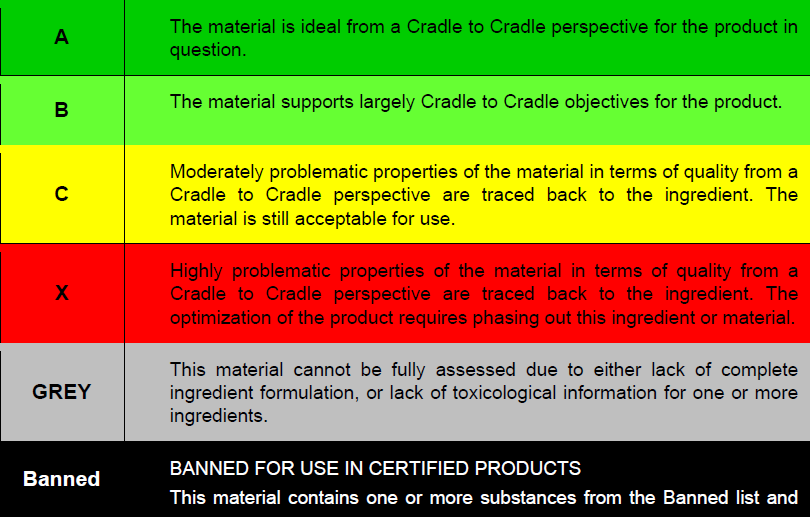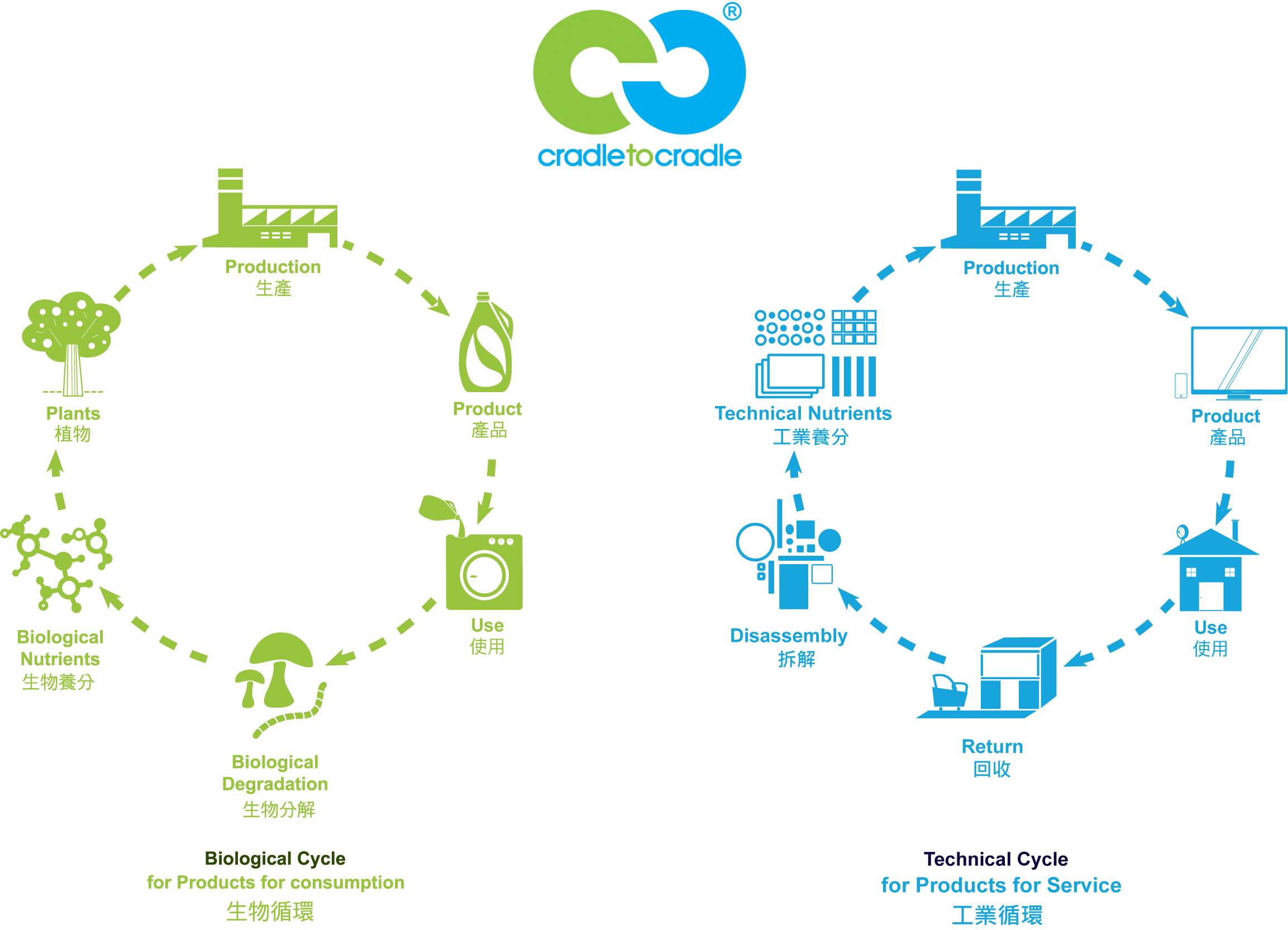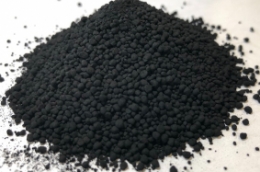ABC-X CATEGORISATION
Cradle to Cradle has a material evaluation method called “ABC-X categorization”. According to health impacts on human and on the environment, substances, materials and products are categorized into A, B, C and X levels. A stands for the preferred choice, B stands for optimized choice but can still be improved, C stands for acceptable choice, and X stands for hazardous choice, for which a phase out strategy should be developed.

BIODEGRADATION
The process by which a substance or material is broken down or decomposed by microorganisms and reduced to organic or inorganic molecules which can be further utilized by living systems. Biodegradation can be aerobic, if oxygen is present, or anaerobic, if not oxygen is present. The OECD defines the appropriate testing methods for ready and inherent biodegradability. If making biodegradability claims for materials that are not commonly known to be biodegradable, testing should be done according to these methods.
BIOLOGICAL CYCLE, or BIOLOGICAL METABOLISM
The cycle in which biological nutrients flow. Any material that comes into intentional or likely unintentional contact with the biological metabolism should be designed to safely come into contact with living organisms.
BIOLOGICAL NUTRIENT
A product usable by defined living organisms to carry on life processes such as growth, cell division, synthesis of carbohydrates, energy management and other complex functions. Any material emanating from product consumption that comes into intentional or likely unintentional and uncontrolled contact with biological systems is assessed for its capacity to support their metabolism. Metabolic pathways consist of catabolism (degradation, decrease in complexity) and anabolism (construction, increase in complexity), both occurring generally in a coupled manner. The status of products as a biological nutrient (or source of nutrients) depends on the biological systems that meet them. They can be more or less complex along the following organizational hierarchy:

TECHNICAL CYCLE or TECHNICAL METABOLISM
The cycle that technical nutrients flow in. Materials potentially hazardous to life and health may be used in a technical metabolism, if they are sequestered from uncontrolled contact with life. Note that biological nutrients may flow in technical cycles (e.g., paper and bio-based polymers).
TECHNICAL NUTRIENT
A product capable to “feed” technical systems. Any material that cannot be processed by biological systems is assessed for its capacity to be processed as a resource in systems of human artifice (“Technical Organisms”). In homology to biological nutrients, technical nutrients are catabolized (deconstruction) and anabolized (construction) according to the following hierarchy:
• (Dismantle and) Reuse
• (Dismantle and) Physical transformation (e.g. plastic remolding)
• (Dismantle and) Chemical transformation (e.g. plastic depolymerization, pyrolysis, gasification)
The management of technical nutrients occurs by transferring ownership to the users of only the service, not of materials. It is the service offering side that manages materials as technical nutrients, once the phase of functional use is over.
DOWNCYCLING
Consequences of design failures to provide products a status as defined biological nutrients or technical nutrients. It is the name for the practice of recycling a material in such a way that much of its inherent value is degraded (e.g. recycling plastic into park benches) revealing poor design of a lifecycle and the related material flows.
UPCYCLING
Any measure and activity in the design phase targeting at optimal handling of products as nutrients.
ECO-EFFECTIVENESS
In contrast to this approach of minimisation and dematerialisation, the concept of eco-effectiveness proposes the transformation of products and their associated material flows such that they form a supportive relationship with ecological systems and future economic growth. The goal is not to minimise the cradle-to-grave flow of materials, but to generate cyclical, cradle-to-cradle ‘metabolisms’ that enable materials to maintain their status as resources and accumulate intelligence over time (upcycling). This inherently generates a synergistic relationship between ecological and economic systems, a positive recoupling of the relationship between economy and ecology.
ECO-EFFICIENCY
Eco-efficiency begins with the assumption of a one-way, linear flow of materials through industrial systems: raw materials are extracted from the environment, transformed into products, and eventually disposed of. In this system, eco- efficient techniques seek only to minimise the volume, velocity, and toxicity of the material flow system, but are incapable of altering its linear progression. Some materials are recycled, but often as an end-of-pipe solution, since these materials are not designed to be recycled. Instead of true recycling, this process is actually downcycling, a downgrade in material quality, which limits usability and maintains the linear, cradle-to-grave dynamic of the material flow system.

LIFE CYCLE ASSESSMENT
Life-cycle assessment (LCA, also known as life-cycle analysis, ecobalance, and cradle-to-grave analysis) is a technique to assess environmental impacts associated with all the stages of a product's life from cradle to grave (i.e., from raw material extraction through materials processing, manufacture, distribution, use, repair and maintenance, and disposal or recycling).
PRODUCT OF CONSUMPTION
A product of consumption is a material or product that is typically changed biologically, chemically, or physically during use and therefore enters the biosphere either by nature or by human intention. As a result, products of onsumption should consist of biological nutrient materials.
PRODUCT OF SERVICE
A product of service is a material or product designed to provide a service to the user without conveying ownership of the materials. Products of service are ideally comprised of technical nutrients that are recovered at the end-of use-phase.
WASTE EQUALS FOOD
Nutrients become nutrients again. All materials are seen as potential nutrients in one of two cycles – technical and biological cycles.


 正體中文
正體中文



